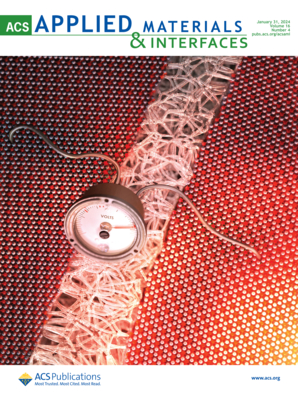Direct Visualization of Interfacial Charge Transfer in CsPbBr3 Perovskite Solar Cells Using Pattern-Illumination Time-Resolved Phase Microscopy
IF 8.3
2区 材料科学
Q1 MATERIALS SCIENCE, MULTIDISCIPLINARY
引用次数: 0
Abstract
This study follows our previous investigation of charge carrier dynamics at the hole transport layer (HTL)/perovskite (CsPbBr3) interface, where pattern-illumination time-resolved phase microscopy (PI–PM) revealed that HTLs significantly influence hole extraction and charge recombination processes. In the absence of an HTL, CsPbBr3 exhibited dominant hole dynamics, which were mitigated by the introduction of Spiro-OMeTAD and P3HT, with the latter showing superior hole extraction efficiency. In this follow-up study, we extend our analysis to electron transport layers (ETLs) and the full ETL/perovskite/HTL structure, and investigate modulation of charge separation at interfaces. Our results show that TiO2, a widely used ETL, enhances electron extraction but still exhibits recombination due to interfacial states. Li and Pt doping further improve charge separation, with Pt-doped TiO2 demonstrating the most significant reduction in recombination and the longest charge carrier lifetimes. When combined with HTLs, the choice of HTL significantly impacts charge extraction: P3HT facilitates more efficient hole removal than Spiro-OMeTAD. The most effective configuration for charge separation and suppression of residual charge carriers was achieved with Pt-doped TiO2 as the ETL and P3HT as the HTL. These findings provide a comprehensive understanding of charge carrier transport in inorganic perovskite solar cells, demonstrating the importance of both ETL and HTL selection for optimizing photovoltaic performance.

利用模式照明时间分辨相显微镜直接观察CsPbBr3钙钛矿太阳能电池的界面电荷转移
本研究是继我们之前对空穴传输层(HTL)/超晶石(CsPbBr3)界面上的电荷载流子动力学进行研究之后的又一项研究,通过图案照明时间分辨相显微镜(PI-PM)发现,HTL 对空穴萃取和电荷重组过程有显著影响。在没有 HTL 的情况下,CsPbBr3 表现出主要的空穴动力学,而引入螺-OMeTAD 和 P3HT 后,空穴动力学得到缓解,后者表现出更高的空穴萃取效率。在这项后续研究中,我们将分析扩展到电子传输层(ETL)和完整的 ETL/perovskite/HTL 结构,并研究了界面处电荷分离的调制。我们的研究结果表明,作为一种广泛使用的 ETL,TiO2 可增强电子萃取,但仍会因界面态而出现重组。掺入锂和铂可进一步改善电荷分离,其中掺入铂的二氧化钛可最显著地减少电荷载流子的重组,并延长电荷载流子的寿命。与 HTL 结合使用时,HTL 的选择会对电荷提取产生重大影响:P3HT 比 Spiro-OMeTAD 能更有效地去除空穴。电荷分离和抑制残余电荷载流子的最有效配置是以掺铂 TiO2 作为 ETL,以 P3HT 作为 HTL。这些研究结果提供了对无机过氧化物太阳能电池中电荷载流子传输的全面理解,证明了选择 ETL 和 HTL 对优化光伏性能的重要性。
本文章由计算机程序翻译,如有差异,请以英文原文为准。
求助全文
约1分钟内获得全文
求助全文
来源期刊

ACS Applied Materials & Interfaces
工程技术-材料科学:综合
CiteScore
16.00
自引率
6.30%
发文量
4978
审稿时长
1.8 months
期刊介绍:
ACS Applied Materials & Interfaces is a leading interdisciplinary journal that brings together chemists, engineers, physicists, and biologists to explore the development and utilization of newly-discovered materials and interfacial processes for specific applications. Our journal has experienced remarkable growth since its establishment in 2009, both in terms of the number of articles published and the impact of the research showcased. We are proud to foster a truly global community, with the majority of published articles originating from outside the United States, reflecting the rapid growth of applied research worldwide.
 求助内容:
求助内容: 应助结果提醒方式:
应助结果提醒方式:


